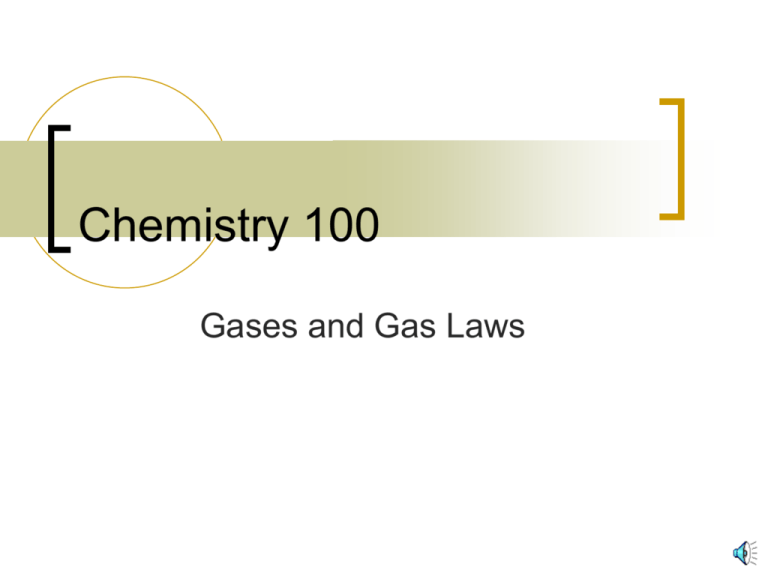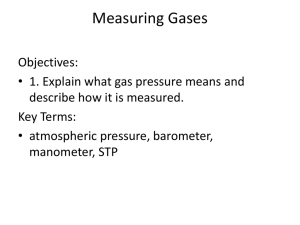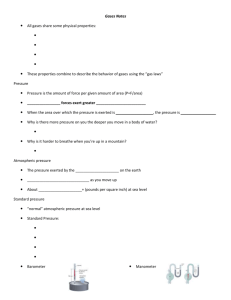Chapter 10 - Gases - X-Colloid Chemistry Home Page
advertisement

Chemistry 100 Gases and Gas Laws The Definition of a Gas Gas - a substance that is characterised by widely separated molecules in rapid motion. Mixtures of gases are uniform. Gases will expand to fill containers. Examples of Gaseous Substances Common gases O2 and N2, the major components of "air" Other gases F2, Cl2, H2 gaseous diatomic molecules H2 and He are the ‘lighter than air’ gases N2O (laughing gas) Three States of Matter Solids Liquids Gases Gases (cont’d) Most molecular compounds are solids or liquids at room temperature, but they can be converted to a gas relatively easily Important exception ionic solids (e.g., NaCl) can't be easily coverted to gases Gases and Vapours What is the difference between a gas and a vapour? Gases normally in the gaseous state at 25°C and 1 atm pressure A vapour is the gaseous form of any substance that is normally in the liquid or solid state at normal temperatures and pressures The Definition of Pressure The pressure of a gas is best defined as the forces exerted by gas on the walls of the container Define P = force/area The SI unit of pressure is the Pascal 1 Pa = N/m2 = (kg m/s2)/m2 The Measurement of Pressure How do we measure gas pressure? Barometer - invented by Torricelli Gas pressure conversion factors 1 atm = 760 mm Hg = 760 Torr 1 atm = 101.325 kpa = 1.01325 bar The Barometer The Gas Laws Four variables were sufficient to fully describe the state of a gas Pressure (P) Volume (V) Temperature (T) The amount of the gas in moles (n) Boyle's Law The gas volume/pressure relationship The volume occupied by the gas is inversely proportional to the pressure V 1/P Temperature and the amount of the gas are fixed V = k1/ P or PV = k1 k1 is a proportionality constant Boyle's Law Charles and Gay-Lussac's Law Defines the gas volume/temperature relationship V T (constant pressure and amount of gas) Note T represents the temperature on Lord Kelvin's temperature Scale V = k2 T k2 proportionality constant Charles and Gay-Lussac's Law An Aside The Kelvin temperature scale Lord Kelvin recognised the significance of the intercept in the volume/temperature relationship All temperature (°C) vs. volume plots extrapolated to 0 volume at -273.15°C Kelvin - absolute 0 all thermal motion ceases The Kelvin Temperature Scale Relating Kelvin scale and the Celcius scale T (K) = [ tc (°C) + 273.15°C] K/°C Freezing point of water: tc = 0 °C; T = 273.15 K Boiling point of water: tc = 100 °C; T = 373.15 K Room temperature: tc = 25 °C; T = 298 K NOTE tc = C; T (K) = K NO DEGREE SIGN Amonton’s Law The pressure/temperature relationship For a given quantity of gas at a fixed volume, P T P = k3 T P1 = k3T1 P2 = k3T2 P1 / T1 = P2 / T2 Amonton's law Amonton’s Law V1 V2 V3 P/ atm t = -273.15C V4 t / C Avogadro’s Law The volume of a gas at constant T and P is directly proportional to the number of moles of gas V = k4 n => n = number of moles of gas Avogadro’s Law The Ideal Gas Equation of State We have four relationships V 1/P; Boyle’s law V T; Charles’ and Gay-Lussac's law V n; Avogadro’s law P T; Amonton’s law Ideal Gas Equation of State We combine these relationships into a single fundamental equation of state the ideal gas equation PV = nRT R is the universal gas constant R = 0.082057 L atm / (K mol) = 8.314 J / (K mol) The Definition of an Ideal Gas An ideal gas is a gas that obeys totally the ideal gas law over its entire P-V-T range Ideal gases - molecules have negligible intermolecular attractive forces Occupy a negligible volume compared to the container volume Standard Temperature and Pressure Define: STP (Standard Temperature and Pressure) Temperature 0.00 °C = 273.15 K Pressure 1.000 atm The volume occupied by 1.000 mole of an ideal gas at STP is 22.41 L! Gas Density Calculations A simple expression for calculating the molar mass of an unknown gas. Molar mass and gas density M = (dRT) / P d = the gas density Partial Pressures Let's consider two ideal gases (gas 1 and gas 2) in a container of volume V. 2 1 2 1 2 1 2 2 1 2 1 1 2 1 Dalton's Law of Partial Pressure In a gaseous mixture, each gas exerts the same pressure as if it was alone and occupied the same volume. the partial pressure of each gas, Pi, is related to the total pressure by Pi = Xi PT Xi is the mole fraction of gas i. Partial Pressures (cont’d) The pressure exerted by the gases is the sum of the partial pressures of the individual gases Let P1 and P2 be the partial pressures of gas 1 and 2, respectively. PT = P1 + P2 = nT (RT/V), PT = n1 (RT/V) + n2 (RT / V) The Mole Fraction The mole fraction is defined as follows For a two component mixture n1 = moles of substance 1 n2 = moles of substance 2 nT = n 1 + n 2 X1 = n1 / nT; X2 = n2 / nT Gas Collection Over Water Gas Collection Over Water Many gas measurements are carried out over water. Water vapour is collected with the gas. PT = Pgas + PH2O Kinetic Molecular Theory of Gases Macroscopic (i.e., large quantity) behaviour of gases. The kinetic molecular theory of gases attempts to explain the behaviour of gases on a molecular level. Kinetic Theory of Gases Gases consist of molecules widely separated in space. Volume of molecules is negligible compared to total gas volume. Gas molecules are in constant, rapid, straightline motion. Collisions are elastic. Average kinetic energy (K.E.) of molecules depends on absolute temperature (T) only. Attractive forces between molecules are negligible. Kinetic Theory of Gases Gas Laws Explanations Gas pressure results from collisions of gas molecules with the container walls. Pressure depends on the number of collisions per unit time how hard gas molecules strike the container wall! Avogadro’s Law Let's increase the amount of gas in the container (T, P constant) More collisions of gas with container wall. V n at constant P, T. Boyle's Law Let's decrease the volume of the container (constant n and T). More collisions of the gas molecules with the container wall and P increases. (V 1/P) Charles’ and Gay-Lussac’s Law Let container volume increase (P, n are held constant). High Temp. Low Temp. The molecules must move faster T must increase. Molecular Speeds K.E. = 1/2 M U2 M = the molar mass of the gas U2 =the mean square speed of the gas This speed is an average speed (some will always be fast, some slow). The Mean Square Speed Kinetic Molecular Theory of Gases allows us to relate macroscopic measurements to molecular quantities P, V are related to the molar mass and mean square seed, U2 P V = 1/3 n M U2 = n R T The Root Mean Square Speed 1/3 MU2 = RT U2 = 3RT / M (U2)1/2 = urms = (3RT/M)1/2 urms = the root mean square speed The Root Mean Square Speed The Mean Free Path Gas molecules encounter collisions with other gas molecules and with the walls of the container Define the mean free path as the average distance between successive molecular collisions The Mean Free Path The Mean Free Path As the pressure of the gas increases, the mean free path decreases, i.e., the higher the pressure, the greater the number of collisions encountered by a gas molecule. Diffusion Diffusion - gradual mixing of gas molecules caused by kinetic properties. Graham's Law Under constant T, P, the diffusion rates for gaseous substances are inversely proportional to the square roots of their molar masses. Graham’s Law r1/r2 = (M2 / M1)1/2 r1 and r2 are the diffusion rates of gases 1 and 2. M1 and M2 are the molar masses of gas 1 and gas 2, respectively. Effusion Effusion - the process by which a gas under pressure goes (escapes) from one compartment of a container to another by passing through a small opening. Effusion The Effusion Equation Graham’s Law - estimate the ratio of the effusion times for two different gases. t1/t2 = (M1 / M2)1/2 t1 and t2 are the effusion times of gases 1 and 2. M1 and M2 are the molar masses of gas 1 and gas 2, respectively. Deviations from Ideal Gas Behaviour The ideal gas equation is not an adequate description of the P,V, and T behaviour of most real gases. Most real gases depart from ideal behaviour at deviation from low temperature high pressure Deviations from Ideal Gas Behaviour at Low Temperatures Deviations from Ideal Gas Behaviour at High Pressures Deviations from Ideal Behaviour Look at assumptions for ideal gas Real gas molecules do attract one another. (i.e., Pid = Pobs + constant). Real gas molecules do not occupy an infinitely small volume (they are not point masses). (Vid = Vobs - const.) The Van der Waal’s Equation Vid = Vobs - nb where b is a constant for specific different gases. Pid = Pobs + a (n / V)2 where a is also different for different gases. Ideal gas Law Pid Vid = nRT The Van der Waal's Equation (cont’d) (Pobs + a (n / V)2) x (Vobs - nb) = nRT Van der Waals’s equation of state for real gases. Two constants (a, b) that are experimentally determined for each separate gas Table 10.3 in text.








